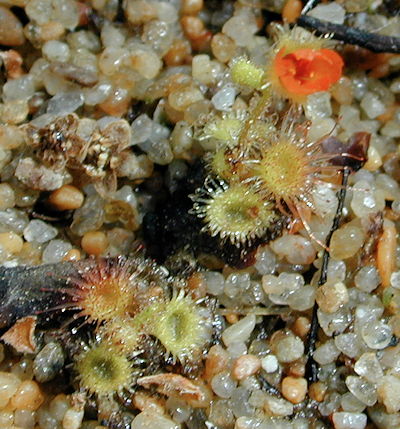Drosera glanduligera is found in south western and south eastern Australia and Tasmania. It can be quite abundant in certain locations. It is a winter growing annual with a very short life span.
In spite of the fact that the plant is widespread in Australia and grows in diverse soil conditions, it can be very challenging to grow in captivity. The first challenge is getting the seeds to germinate. The second is keeping the plants alive.
It is well worth the effort growing Drosera glanduligera. The plant has unique catapult tentacles. Siggi Hartmeyer has an excellent video documenting the capabilities of the plant: The Catapult-Flypaper-Trap (in German with English subtitles).
The seeds of Drosera glanduligera require cold nighttime temperatures to germinate and grow. Kamil Pásek of Best Carnivorous Plants reports that keeping the seed pots at 8 to 12°C (46 to 54°F) is sufficient to get reasonable germination rates. This may be difficult to do. Siggi Hartmeyer recommends nighttime temperatures of 1 to 8°C (34 to 46°F) while daytime temperature can be 15 to 25°C (60 to 78°F). He keeps the plants in a cold greenhouse that only uses supplemental heating to keep the temperatures above freezing. If you live in a Mediterranean climate that naturally has late fall and early winter temperatures in this range, plant the seeds outside in the fall. If you live in a colder climate, try planting the seeds during the winter and germinating the seeds in window in a garage or cold frame. Or you could put the pot with the seeds in a refrigerator at night.
Scarification will help the seeds to germinate quicker. If you are trying to germinate the seeds during the winter under lights in a cool basement, scarification should help. Please see Sowing Seeds Step-by-Step for more details on starting seeds and the growing guide Growing Subtropical Drosera for more information on growing Drosera in general but keep in mind that Drosera glanduligera wants to be cool. Standard peat/sand CP soil mix works well.
Keeping the plants alive can be a problem unless you feed them enough. For the plants to grow well and bloom you need to feed them regularly if they are not catching enough insects on their own. Generally when the plants are small they need to gorge on springtails to do well. Larger plants appreciate small flies. Small pieces of hydrated dried blood worms and/or a dilute foliar fertilizer will work.
It is also important the plants continue to get cold temperatures at night until they are large enough to bloom. Siggi Hartmeyer reports the plants start blooming when the nighttime temperatures are above 8°C (46°F). Growing the plants outside in a Mediterranean climate violates this regularly during the winter. Although the plants do want full sun, keeping the plants in the shade during a warm spell helps keep them from blooming too early.
-- John Brittnacher
For more information please see:
Gibson, Robert (2001) Highlights of a trip to Western Australia. Carniv. Pl. Newslett. 30(3):78-83 ( PDF )

Drosera glanduligera in bloom in captivity. The plants are about a cm wide. These plants are underfed.

Drosera glanduligera in the wild. Photo by Robert Gibson, Carniv. Pl. Newslett. 30(3):78-83.
